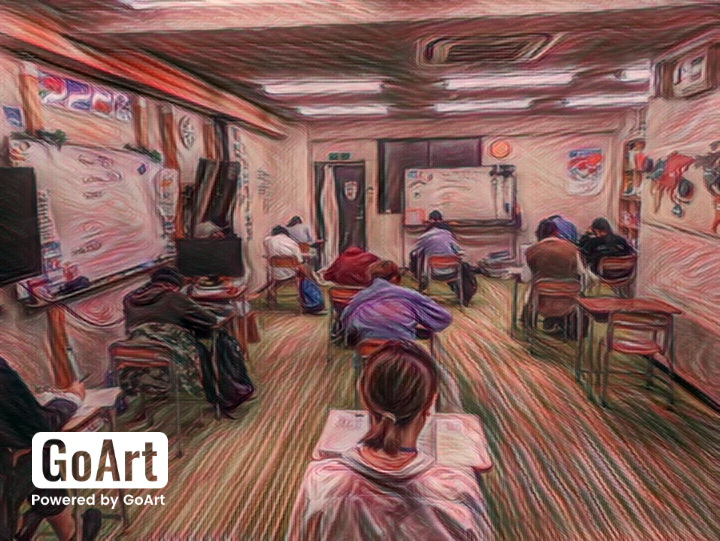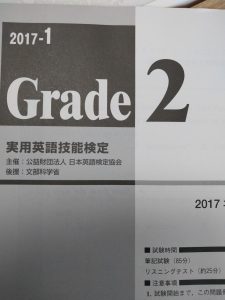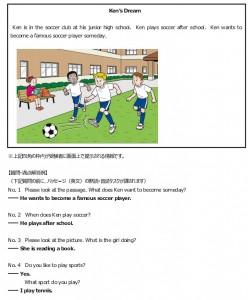Running STEP Eiken Tests as a Small School

We ran STEP Eiken tests today at our school. About 170 students took the tests, seven staff were involved in invigilating, dealing with students and parents, and it took the whole of a Sunday.
Is it worth it?
We’ve been a STEP Eiken test center for a long time now (almost 20 years?) and over that time we have made a lot of changes.
If you are a small or medium school, and you are thinking about becoming a STEP Eiken test center, then this blog post should give you some context and help you make the decision.
Financially speaking
From a financial point of view, being a STEP Eiken test center makes no sense at all. Eiken charges a lower fee to take the test at a privately run center and only pays around 100 yen per student to the venue. This doesn’t cover costs (staff, electricity, printing, etc.).
The fee to take the test at a public (Eiken-run) site is higher, which allows them to cover their costs. This pricing model is pretty unfair to the unofficial venues in my opinion and makes it unattractive to run the tests, at least from a financial point of view.
Non-financial factors
So why have we run STEP Eiken tests for almost 20 years then?
Well, there are a number of non-financial factors that make it worth it to us.
First and most important, we can provide value by offering it as a service to our students. Being able to take the test in a familiar environment, with people who can help with admin and practical issues (a number of students today forgot to bring a pencil, or didn’t know their address, or were late, and we can help) is really valuable, especially for younger children.
It gives the school an aura of importance too, providing a kind of official recognition that appeals to some parents and prospective customers.
And it can make a school seem more academic, which might be important in order to retain students as they get older and parents start eyeing switching to juku.
Things we have implemented
When we first started running STEP Eiken tests, we did them three times a year. This provided the maximum flexibility and convenience for our students, but was a huge amount of work for us.
After a while we went to twice a year, and then finally just once a year. We used to do the January session as it clashed the least with school sporting events, but some students found they didn’t get their results in time for private school applications, we we have now moved to running the test once a year in October. If students want to take the test in June or January they can go to a public test site.
At first we just had students apply to take the test when they wanted to: we didn’t teach or prepare for the test, just ran the tests on demand.
After a while we started doing special sessions to help students prepare for the speaking and writing sections: just 60-90 minutes outside of regular class time. These were very popular and, due to the very formulaic nature of the STEP Eiken writing and speaking, effective at helping students pass those sections. You can get free PDF copies of our writing practice materials here (scroll to the bottom of the page).
The most recent change has been to start doing STEP Eiken 5 with all our elementary fifth grade students. We do a couple of practice questions every week April to October, and then a practice test in class the week before the real one. In 2022 every single one of our fifth graders passed the test, which was nice for us and very motivating for them (STEP Eiken 5 is designed to be taken by JHS1 students at the end of the year).
Sixth grade students take the STEP Eiken 4 test if they passed level 5, and level 5 if they haven’t passed it yet. They practice in class in the same way, doing practice questions from April to October and a practice test.
Final thoughts
I’m not a big fan of STEP Eiken. I think it has a lot of problems, and I am not very impressed with the company that runs it. If there were a good alternative to it I could be very keen to change.
But in terms of recognition, price, convenience, and usefulness, STEP Eiken is currently hard to beat for elementary, junior high, and even senior high school students.
Students, parents, and schools are aware of the tests, want to pass them, and use them for school entrance purposes. We have found it useful and valuable to run the tests at our school, and will likely continue doing so in the future.
(we also run the JAPEC, Junior UN Eiken, TOEFL ITP, Eiken IBA, and TOEIC tests at our school)
How about you? Do you run STEP Eiken or other eiken tests at your school? Any comments or questions?
Changes to the STEP Eiken Tests (June 2017)
There have been a few…
The STEP Eiken Test is probably the best-known and most widely-recognized test of English for Japanese schoolchildren. It is closely tied to the school curriculum and the organization that produces it is trying to get more involved with university entrance tests once they are mandated to be 4-skills (from 2020).
Recently there have been quite a few changes to the STEP Eiken tests, most of which took me by surprise, so this post is to give other teachers a heads-up as to what has changed and what the latest version of the test looks like.
It seems as though the Eiken Foundation is trying to make the tests more rigorous in line with the new Course of Study and objectives for English education in Japan (particularly with regards to the upcoming changes to the university entrance tests).
I’ll describe each level in detail below, but the general changes are:
- the test seems to have gotten harder overall (the vocabulary and reading sections seem more difficult to me)
- there are new written sections in levels 3 and pre-2 (2, pre-1, and 1 already had a written section)
- there are new, optional, online “speaking” tests for levels 5 and 4
- the interview tests for levels 2, pre-2, and 3 are more rigorous: you now have to pass each section in order to pass the test. Merely getting a passing score is no longer enough to pass (we had a student fail with 20 points last time)
- interview examiners can no longer keep the interview cards and manuals, which is going to make practicing more difficult in the future 😉
Grade 5
The grade 5 test is 25 minutes for the paper and 22 for the listening. It consists of:
15 vocabulary questions (choose the word that goes in the blank)
5 conversation questions (choose the phrase that goes in the blank)
5 ‘rearrange the sentence’ questions (put the words in order)
10 listening questions with reference pictures
5 listening questions where you choose a written answer
10 listening questions where you answer about a picture
Overall I think the test seemed similar to previous years. No huge changes.
Grade 4
The grade 4 test is 35 minutes for the paper test, and 28 for the listening. It consists of:
15 vocabulary questions (choose the word that goes in the blank)
5 conversation questions (choose the phrase that goes in the blank)
5 ‘rearrange the sentence’ questions (put the words in order)
10 questions based on reading passages (one easy, one medium, and one difficult)
10 listening questions with reference pictures
20 listening questions where you choose a written answer
The reading section seems to have gotten harder in this test. The final text was really hard.
Grade 3
The grade 3 test is 50 minutes for the paper test, and 25 for the listening. It consists of:
15 vocabulary questions (choose the word that goes in the blank)
5 conversation questions (choose the phrase that goes in the blank)
10 questions based on reading passages (one easy, one medium, and one difficult)
1 writing exercise where students have to write 25-35 words and answer a question giving two reasons. The question this time was: “Where do you want to go during your summer vacation?”. They seem to be using old questions from the level 3 speaking test for this section.
10 listening questions with reference pictures
20 listening questions where you choose a written answer
The reading section seems to have gotten harder in this test. The final text made me think. The new writing section is going to trip up students who haven’t done much writing or practiced for this section of the test.
Grade pre-2
The grade pre-2 test is 75 minutes for the paper test, and 25 for the listening. It consists of:
20 vocabulary questions (choose the word that goes in the blank)
5 conversation questions (choose the phrase that goes in the blank)
5 vocabulary and phrase questions (choose the words that go in the blank in longer passages)
7 questions based on reading passages (one easy, one medium, and one difficult)
1 writing question where they examinees have to write 50-60 words and answer a question giving two reasons. This time the question was: “Do you think it is better for people to eat in restaurants or at home?”.
10 listening questions with no visual reference
20 listening questions where you choose a written answer
Overall this test felt slightly harder. Again, the writing question is similar to past interview questions for grade pre-2. The pre-2 test feels too long now. I think they have given too much extra time for the writing section.
Grade 2
The grade 2 test is 85 minutes for the paper test, and 25 for the listening. It consists of:
20 vocabulary questions (choose the word or phrase that goes in the blank)
6 vocabulary and phrase questions (choose the words that go in the blank in longer passages)
12 questions based on reading passages (one easy, one medium, and one difficult)
1 writing question where they examinees have to write 80-100 words and answer a question giving two reasons. This time the question was: “Today, more and more young people are starting their own companies. Do you think this is a good idea?”
30 listening questions where you choose a written answer
Overall this test felt slightly harder. Again, the writing question is similar to past interview questions for grade 2. This test also feels a bit too long.
I haven’t seen the new grade pre-1 or 1 tests yet, but I presume they haven’t changed as much. You can see past papers and a lot more information at the STEP Eiken website.
Anything to add? How are you finding the new tests?
STEP Eiken 4-kyu, 5-kyu Speaking Test from June 2016
Where are they going to find the interview testers???
I just read this press release/informational pamphlet on the STEP Eiken website (thanks for the tip, Mary!)
From June this year (ie the 2016-1 session of the STEP Eiken test) 5-kyu and 4-kyu will have a speaking test.
At first I was extremely surprised and wondered where they were going to find the interviewers to cope with these thousands of additional test, but then I read the content.
The new speaking tests will be online, can be done at any time, and will not affect whether students pass or fail the main STEP Eiken test. Instead students will receive an additional pass/fail certificate for the speaking test. I believe from the write-up that students will record their spoken answers and submit them via a website. Presumably Eiken will mark them using software, so it will be important to stick to the prescribed answer formats.
I’m guessing they will get those two annoying voice actors to do the audio (who is that woman, by the way? Sendai City got her to do the new subway line safety announcements, so now I have to listen to her every day rather than just for a couple of months a year…).
This is the content of the 4-kyu test.
And here is the 5-kyu.
As you can see (click on the graphics to make them bigger or just look at the original eiken version), they are both kind of watered down versions of the 3-kyu speaking test. Don’t know how they are going to guarantee the reliability of the test if students can take it at home with their parents or at school with their teachers, but I guess the stakes aren’t very high here and that’s why they decided to have it run parallel to (instead of be a part of) the paper test.
It’s probably a positive development and hopefully will put more emphasis on speaking skills for junior high school students. I don’t like that students have to read to answer the questions. It would be better to have them exclusively based on pictures and audio like the Cambridge YLE tests, but such is eiken 🙂
What do you think about the new speaking tests?
curriculum eikaiwa expectations levity life in Japan testing tests
by sendaiben
leave a comment
Social Skills Written Test
You’ve probably seen this already, it’s all over the English J-web, but just in case (thanks to goodandbadjapan):



